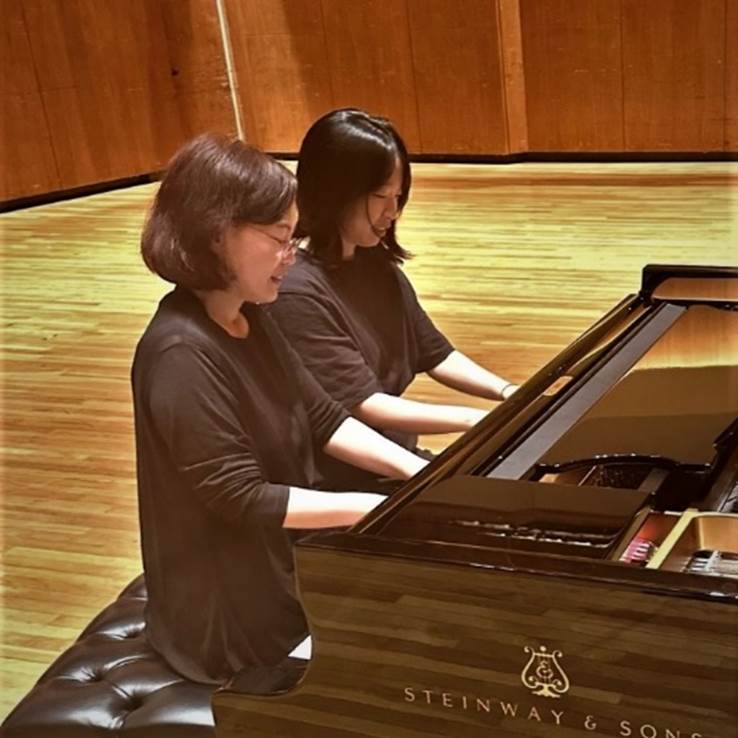Rhythms of Korea
Twelve Piano Compositions Based on Korean Folk Songs
by Sojung Lee Hong
The CD album, “Rhythms of Korea” is my second Korean folk song project after “From East to West” (2020). The purpose of both albums is to introduce new piano compositions based on Korean folk songs and promote the aesthetic and pedagogical value of this genre. In the second album, twelve pieces are selected to demonstrate this purpose. The six solo pieces call for high-level piano technique, and the six duet pieces are less technically demanding yet more accessible for enjoyment. Each composition utilizes one distinctive rhythm which functions as the scaffolding of the piece. I sincerely hope the listeners will be delighted by the stunning differences in their compositional style and the cross-cultural beauty between East and West.
Ever since Austro-German composers such as Haydn, Mozart, and Beethoven established major forms of classical music, musicians from other cultures have expanded it into diverse styles by adding “exotic” musical elements: Chopin with Polish dance rhythms, Dvorak with Bohemian folk songs, and Liszt with Hungarian gypsy music. In the 20th century, classical music composers continued to integrate “exotic” elements from existing musical styles such as Spanish flamenco, American jazz, and the Argentine tango. However, Korean music was unknown to the Western world until the mid-20th century.
The integration of Korean music into classical music can be traced back to as early as the 1960s. Alan Hovhaness (1911-2000), a prolific American composer and a recipient of a Fulbright fellowship, recognized unique aspects of traditional Korean instruments upon his visit to Korea and included them in his orchestral compositions. On the other hand, Isang Yun (1917-1995), a Korean-born composer whose careers flourished in Germany was the first Korean classical music composer who had a decisive impact on the West for his unique compositional technique inspired by Korean music.
Recently, Samul-nori, a Korean folk percussion genre, has gained international recognition for its dynamism and rhythmic mobility. Furthermore, BTS (the Korean pop music band with worldwide acclaim) has embraced a wide range of genres in their repertoire including Korean folk music. With the rigorous expression of and the increased interest in Korean music, more Korean composers have begun to experiment with the musical fusion of Western and Korean music.
There are considerable differences between Western classical and Korean folk music. While Western music is constructed upon the three main elements of melody, rhythm, and functional harmony, Korean folk music is made only of melody and rhythm. In other words, Western music is structured along intentional harmonic progressions, whereas Korean folk music heavily relies on successive rhythm called Jangdan.
The two most popular rhythms in Korean folk music are called Semachi (9/8 meter) and Good-geori (12/8 meter). In this CD album, Semachiis used in Miryang’s Arirang, and Good-geori in Weaver’s Song and Odoltdogi. Other commonly used rhythms in compound meter are Joong-mori (12/4 meter) and Jajin-mori (12/8 meter in a fast tempo). Joong-mori is used in A Variation on a Korean Peasant Tune, Jeolla Farmers’ Song, and Sangju Farmers’ Song. Jajin-moriis used in Korean Palace for Piano and Winnower’s Song.
Eon-mori (10/8 meter, 3+2+3+2) is a combination of triple and duple meters, expressing a dramatic turn in a story. Gangwondo Arirang uses Eon-mori. One of the most advanced rhythms is Chil-chae (36/8 meter, 3+2+3+2, 3+3+3+2, 3+2, 2+3+3+2). Jang-gu Nori for Piano uses Chil-chae until the rhythmic momentum is interrupted by a slow folk tune. Simple duple meter does exist in Korean folk music: Dongsahl-poori(4/4 meter) used in Korean Market Song and Hwee-mori (2/4 meter) in ARARI for Solo Piano.
Jang-gu Nori for Piano (1992) by Dae-seong Kim
Jang-gu Nori for Piano is based on the intense Samul-nori rhythm called “Chil-chae.” In this virtuosic piece, the piano is handled as jang-gu, the Korean traditional percussion instrument shaped like an hourglass. The relentless repetitions of the complex rhythm in dissonant harmony creates dramatic energy throughout the piece. The slow middle section uses a Korean folk tune from the North Jeolla Province, the southwestern region of Korea. Dae-seong Kim (b. 1967) has specialized in integrating idioms of traditional Korean music into grand genres of Western music such as symphony, concerto, opera, musical, and cantata. In all his compositions, the spirit of Korea prevails. He received multiple Grand Prizes including the ARKO Contemporary Orchestra Music Festival and the KBS (Korea Broadcasting System) Music Composition Competition, and his compositions have been performed in Korea and Europe.
Korean Market Song (1997) by Dong-il Sheen
Out of many different versions of Jang Taryeong (Song of Street Entertainers), the tune used in this piece is collected in North Gyeongsang Province, the southeastern region of Korea. Throughout the piece, both the main melody and free episodic passages are persistently presented in the ‘white-keys-only’ harmonic structure based on the pentatonic scale. The basic rhythm generates strong regularity and robust energy in 4/4 meter until it reaches a climax in 12/8 meter. Despite the ‘white-keys-only’ rule, the piece challenges pianists with highly sophisticated rhythmic variants. The humorous, brave, and exciting spirit of the street entertainers fills every corner of the piece. Dong-il Sheen (b. 1965) earned international recognition as the composer of Yellow Umbrella (Picture Book + Music CD), the 2002 New York Times Best Picture Book. His interest in Korean music and literature began in his teenage years and gradually blossomed during his graduate studies at New York University. His compositions encompass diverse genres beyond classical music, including vocal and instrumental concert works, opera, musical theater, and film music.
A Variation on a Korean Peasant Tune (1997) by Geonyong Lee
This piece is based on the Korean folk tune called Sangju Moshimgi Norae (Sangju Farmers’ Rice Planting Song) from North Gyeongsang Province, the southeastern region of Korea. The 16-measure, simple folk tune in a relaxed triple meter is presented in eleven variations of contrasting characters. The piece unfolds unlimited possibilities of the piano with character changes and harmonic buildup. Also, the recurring 3-note motive in the descending 4th interval binds the entire piece. Mysteriously, the feel of Joong-mori seeps into each variation, regardless of the changes of tempi and figurations. Geonyong Lee (b. 1947) is a prolific composer whose oeuvre covers wide genres and diverse styles. As one of the most influential composers in Korea, he taught as a professor of composition at Seoul National University and Korea National University of Arts, and served as the 4th President of KNUA. Since the 1980’s, he has led Korea’s musical nationalism movement through music, speech, and writing.
Miryang’s Arirang (2014) by Insik Lee
Arirang is the most beloved Korean folk song listed as a UNESCO Intangible Cultural Heritage. Approximately 40 different versions of Arirang have been passed down to the present day. This fantasia-style piano piece uses the Arirang from Miryang, located in the southeastern region of Korea. After the captivating beginning with improvisatory scales and broken chords, the piece introduces the refrain of the tune. Delightful liveliness is conveyed by the persistent use of the 5-note motive in Semachi. This main motive outlining a minor third continues to change ravishingly through different keys and tempi and becomes a unifying force of the piece. Insik Lee (b. 1963), a professor of composition at Sungshin Women’s University, is devoted to research on Arirang and its reinterpretation within the context of Western music. This piece is one of his many Arirang-themed compositions performed at a series of concerts in the 2010s.
Korean Palace for Piano (2021) by Jae Hyeok Jang
This energetic miniature is based on Gyeongbok-goong Taryeong, the folk tune from the 19th century. It was sung during the reconstruction of Gyeongbok Palace located in Seoul, the capital of the Joseon Dynasty. Singing of the lively tune may have increased the efficiency of labor. Also, the use of syncopation and the frequent shifts between triple and duple divisions of the beats give urgency and excitement. This piece was commissioned by the Sejong Music Competition and used as a required piece in 2021-2022. Jae Hyeok Jang (b. 1969) has served as a professor of music, the Chair of Composition/Theory department, and the Director of Moody Campus Orchestra at Moody Bible Institute since 2011. The theme of his compositions is to connect Korea’s affection, “hahn” (deep grief), to the realm of blessing. His music has been widely performed and commissioned in Europe, Asia, Australia, and the USA.
ARARI for Solo Piano (2023) by Misook Kim
The folk song used in this piece is Jeongseon Arirang (Arari) from Gangwon Province, the east central, mountainous region of Korea. There are two contrasting parts in the folk tune: the slow, long Arari and the fast, dense Arari. Both parts are found in ARARI for Solo Piano with a fast-slow-fast design. The slow middle section with intricate melodic lines and minor 2nd/3rd trills conveys sorrow and nostalgic bitterness. The brisk outer sections are filled with wild alternations of chords, producing energy, humor, and excitement. Misook Kim (b. 1963), a bold modernist with a touch of transcendence, won several coveted awards including International Alliance for Women in Music (IAWM) Judith Zaimont Award and the 2018 Global Music Awards. She has served on the composition/theory faculty at the Conservatory of Music in Wheaton College since 2006. (sample audio)
Korean Folksong Suite for Piano Duet by Dong-il Sheen
Weaver’s Song (2012)
Odoltdogi (2012)
Jeolla Farmers’ Song (2012)
Winnower’s Song (2012)
Sangju Farmers’ Song (2023)
Gangwondo Arirang (2022) (sample audio)
This delightful collection consists of six piano duets based on Korean folk songs. Each of the six folk songs are from different regions of the Korean peninsula: Gyeonggi (west central), Jeju (the southernmost island), Jeolla (southwest), Hwanghae (northwest), Gyeongsang (southeast), and Gangwon (east central).
The folk tunes, rhythms, and the spirit of the lyrics remain intact in all six pieces. The tunes are repeated with slight variations, and new episodes intervene freely to unfold stories and emotions of people. This unpretentious piano music exists to ease their hardships from labor, help them satirize corrupt authorities, or cheer them up from mundaneness. Above all, compound meters are well suited for storytelling: No. 1 & 2 in 12/8 meter (Good-geori), No. 3 & 5 in 12/4 meter (Joong-mori), No. 4 in 12/8 meter (Jajin-mori), and No. 6 in 10/8 meter (Eon-mori).
The first four pieces were commissioned by the Duo Ryu and premiered in 2012 by Seung-ji Ryu and Jong-hee Ryu. The fifth and sixth pieces were commissioned for this CD project. As Brahms’ Hungarian Dances swept into the Western music world in the 19th century and became a staple of the classic repertoire, I hope this type of works based on Korean folk music will offer a new horizon for the ever-changing, global music community.
For more information, please contact Dr. Sojung Lee Hong at shong@judsonu.edu.






